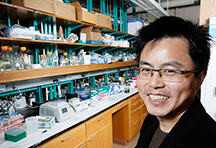Dendrimer technology gets a grip on cell proteins, could improve cancer treatment
November 11, 2015
 |
|
Purdue biochemistry professor W. Andy Tao's TITAN technology uses tiny dendrimers to illuminate complex cell processes. (Purdue Agricultural Communication/Tom Campbell) |
WEST LAFAYETTE, Ind. - Purdue researchers have devised a way to capture the finer details of complex cell processes by using tiny synthetic particles known as dendrimers, a technology that could lead to more targeted treatment for cancer.
A precise understanding of how cells engulf small particles, a process known as endocytosis, could help researchers improve drug delivery and reveal the mechanisms of viruses. But the particles "eaten" by cells and the proteins that control cell entry pathways are too little for conventional technologies to detect.
W. Andy Tao, professor of biochemistry, and his collaborators developed a method that sends dendrimers into cells to track, capture and isolate the proteins that regulate the cell internalization process, identifying 809 proteins involved in cell entry pathways.
The technology, known as Tracing Internalization and TrAfficking of Nanomaterials or TITAN, "helps us understand how cells internalize extracellular particles and how they move these particles around," Tao said. "This is all useful, valuable information for the future as we try to disrupt those processes to keep harmful things like viruses out or work with the processes to deliver a helpful drug."
Dendrimers are symmetrically branched nanoparticles, similar in size to naturally occurring proteins. Meaning "tree-like" molecule, a dendrimer's small size and structure make it an ideal courier for transporting a variety of molecules via its many branches into a cell. One of the most valuable roles of dendrimers is targeted drug delivery for diseases such as cancer. Dendrimers can selectively deliver medicine to cancer cells unlike chemotherapy, which destroys healthy and cancerous cells alike.
Tao and the team chemically modified the dendrimers before sending them into cells with a fluorescent tag that would make the dendrimers easier to spot as they traveled within the cell; a photoreactive crosslinker that would enable dendrimers to attach to proteins under UV radiation; and a "handle" with which researchers could fish out the dendrimers from the rest of the cellular material.
When the researchers irradiated the cells, the dendrimers inside grabbed all proteins in their surroundings, providing a real-time, freeze-frame shot of which proteins regulate endocytosis. The team irradiated the cells at three different time intervals - 30 minutes, an hour and two hours.
"We saw different molecules at each time point that told us where the dendrimer was and by which mechanisms it was delivered into the cell," Tao said. "Say you drove to Wal-Mart, but instead of telling me which roads you traveled, you took photos of buildings and landmarks at different time points along the way. Those images will tell me which roads you took. This is the same method."
The researchers used mass spectrometry to isolate and identify hundreds of proteins involved in endocytosis, confirming mechanisms that many biologists had hypothesized previously.
Knowing which proteins guide endocytosis and at which stages could help researchers refine the delivery of nanomedicine and possibly make it more mobile in cells, Tao said.
"We can extract a lot of crucial information from TITAN," he said. "This is a platform technology that opens a new way to study many small-scale biological processes in the cell."
Some of TITAN's potential applications include determining how viruses enter and travel inside cells, revealing how cancer cells communicate with one another and helping track where nanoparticles end up inside the cell, a feature that is relatively unknown.
"A lot of nanotechnology is being developed, but we really have no idea what safety or toxicity issues might be involved," Tao said. "Understanding where these nanoparticles go in the cell and if they degrade over time is important. TITAN can track how nanoparticles move in the cell and whether they end up in the nucleus - which could be a problem - or in the cell's 'garbage disposal.'"
Tao collaborated on the study with Alexander Wei, professor of organic chemistry, and Laurie Parker, previously of Purdue's Department of Medicinal Chemistry and Molecular Pharmacology and now an associate professor at the University of Minnesota.
The study was published in the Journal of the American Chemical Society and is available to journal subscribers and on-campus readers at http://pubs.acs.org/doi/full/10.1021/jacs.5b07875
The National Institutes of Health grants 5R21RR025802 and 5R01GM088317 and the Purdue University Center for Cancer Research provided funding for the research.
Writer: Natalie van Hoose, 765-496-2050, nvanhoos@purdue.edu
Source: W. Andy Tao, 765-494-9605, taow@purdue.edu
ABSTRACT
Time-resolved proteomic visualization of dendrimer cellular entry and trafficking
Linna Wang 1; Li Yang 1; Li Pan 2; Naveen Reddy Kadasala 3; Liang Xue 1; Robert J. Schuster 2; Laurie L. Parker 2; Alexander Wei 3,4; W. Andy Tao 1,2,4
1 Department of Biochemistry, Purdue University, West Lafayette, IN 47907, United States
2 Department of Medicinal Chemistry & Molecular Pharmacology, Purdue University, West Lafayette, IN 47907, United States
3 Department of Chemistry, Purdue University, West Lafayette, IN 47907, United States
4 Center for Cancer Research, Purdue University, West Lafayette, IN 47907, United States
E-mail: taow@purdue.edu
Our understanding of the complex cell entry pathways would greatly benefit from a comprehensive characterization of key proteins involved in this dynamic process. Here we devise a novel proteomic strategy named TITAN (Tracing Internalization and TrAfficking of Nanomaterials) to reveal real-time protein-dendrimer interactions using a systems biology approach. Dendrimers functionalized with photoreactive crosslinkers were internalized by HeLa cells and irradiated at set time intervals, then isolated and subjected to quantitative proteomics. In total, 809 interacting proteins crosslinked with dendrimers were determined by TITAN in a detailed temporal manner during dendrimer internalization, traceable to at least two major endocytic mechanisms, clathrin-mediated and caveolar/raft-mediated endocytosis. The direct involvement of the two pathways was further established by the inhibitory effect of dynasore on dendrimer uptake and changes in temporal profiles of key proteins.
Ag Communications: (765) 494-2722;
Keith Robinson, robins89@purdue.edu
Agriculture News Page

